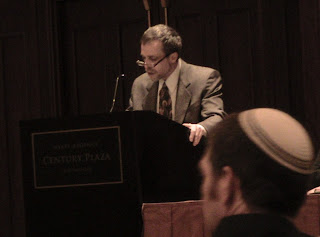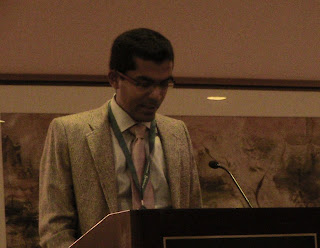 With the 2010 conference of the Association for Jewish Studies (AJS) having occurred this week, I realized I still hadn't posted my summaries of the third and last day of last year's AJS conference (I posted the first day and the second day much earlier). As much as I had wanted to go this year, making it the third straight AJS conference for me (and I could've stayed with my sister and her husband in Boston), we decided that I would stay here in California instead. Nota bene that this isn't exactly the best written, as it is primarily the notes I took whilst the sessions were in progress.
With the 2010 conference of the Association for Jewish Studies (AJS) having occurred this week, I realized I still hadn't posted my summaries of the third and last day of last year's AJS conference (I posted the first day and the second day much earlier). As much as I had wanted to go this year, making it the third straight AJS conference for me (and I could've stayed with my sister and her husband in Boston), we decided that I would stay here in California instead. Nota bene that this isn't exactly the best written, as it is primarily the notes I took whilst the sessions were in progress.- - - - -
For the third and last day of the conference, after arriving and some schmoozing, I first went to the session on "Orthodoxy Revisited". The first paper delivered was “Samson Raphael Hirsch: The Chimera of ‘Self-Explanatory’ Scripture” by Alan T. Levenson, although I showed up about a halfway through, so I didn't quite catch everything from it. Levenson said that Hirsch found Mendelssohn philosophically wanting. 
Hirsch advocated reading the Bible in its original versus in a German (vernacular) language. When he was in Frankfort in 1860s and 1870s, worked on his translation. Differences in keri and ketiv, trop, and big and small letters. He resisted Christian readings throughout. It was unique – pronouncing universalism. It appears as culmination of the study of bible. Hirsch was not haredi – he stands within German tradition of elevating Torah study.

The second presenter was Martin I. Lockshin, who spoke on “Dueling Prayerbooks: ArtScroll, Koren, and Contemporary Orthodox Values”, which, he said, arose from a book review about the Koren siddur. The “Artscroll Takeover” took place 25 years ago and the best known product, published 1984 is their siddur. Many orthodox shuls have them, even MO, but notes are haredi. But now there is competition in the prayerbook market with the Koren-Sacks siddur. Professor Lockshin (who was one of three IRF members [that I counted] at the conference (him, Professor Don Seeman and me)) spoke on the differences between the Artscroll Siddur and the Koren-Sacks siddur, success of the Artscroll siddur, as well as the broader shift to the right, the resulting liberal shift and his conclusion on The Siddur Wars of 2009. In the q and a:
The translation wasn’t done solely to sanitize the language, but also in a fashion to effectuate strangification, that is, the language used is not the same usage we use in a daily fashion, so it was successful in what it was trying to do.
Artscroll came out at a time when Modern Orthodoxy was not lekhathilah, but as an outreach method for haredi Jewry; it was “nicely timed” as presenting haredi values to a modern audience.
The third paper(”A Woman on the Bima means an ignorant man”?) Jessica Rosenberg “’Blessed is he who says and does’: Jewish Law, Gender, and Communal Identity”
Turning to theoretical models outside of halakhah to give us a better understanding of response literature
Strangification
Successful in what it is doing
Not a sanctifying factor but differentiating discourse

How do they set their boundaries? How do they …agenda
Creating communal narrative versus community deciding
An ingroup attempting to redefine the nomos is seen as attempting to create a new one
Opened up attacks from both sources and goals – Shapiro
Undergird with own notions of halakhic legitimacy Jessica second half and conclusion. Jerome Chanes said – 2 Riskins: 1969 – courageousness – 2009 – conservative mostly off the deep end
Artscroll came out at a time not when MO was לכתחילה but as outreach method. It was “nicely timed” as presenting haredi values to a modern audience.
After speaking with some of the presenters and others following the first session, I then went to the second session, "Social Attitudes and Cultural Constructions in Biblical Israel", albeit missing the first half of Elaine Goodfriend’s “Another Look at Animals in the Hebrew Bible”.

Names of people with animal names; Animal life central to the concerns of Israel; Humans dependant upon animals
Dung for fuel; Food, leather, wool; Shared habitation.
The second paper delivered was “The Assembly of Yahweh’s People: Judahite Pilgrimage and Israelite Muster” by Stephen Russell. I don't have anything to note from that paper....

The third paper was given by Esther Fuchs on “Intermarriage in the Hebrew Bible: Gender, Exogamy, and Nation”.

Intermarriage is legally proscribed.
Performance of identity is gendered – endogamy is feminine, the body of the nation; exogamy = masculine
When there are foreign men and Israelite women, the men are violently dealt with, such as the King of Gerar and Avimelekh, so, too, with Shkhem. In Genesis 34, rape is racialized. Realizing the gravity of the sexual laws. The story pokes fun at Shkhemites for their sexual mores – to have sexual intercourse first and then to take her is not the proper way, that is the way of prostitutes. “Exogamy with an Israelite woman leads to mayhem and violence.” Proscription of exogamy w/ Shkhem may not just be sexual transgression, but also national. Domestic space versus foreign nation.
Book of Esther implies that only in national crisis is it permitted - no mention of legal, political, etc. stuff with her. Mordechai giving her over in keeping with.
Exogamy with erasure.
Israelite woman is neither inside or outsider ; she has potential to deconstruct rather than produce binary. Focusing on Israelite women’s endogamy and problematic of exogamy for them; men different.
The fourth paper, “Impurities and Gender in Ezra-Nehemiah”, was delivered by Elizabeth Goldstein.

Niddah as nation in Ezekiel and then now with Impact of foreign women. Collective impurity affects how we think of gender. Woman’s body as useful for reproducing, but when menstrual, not (expendable). There's always a link between niddah and gender. Moral impurity seen with having these foreign women. Collective nature of the impurity makes it important for us to consider.
Having had trouble parking at the nearby mall (presumably due to it being heavy shopping season as Xmas occurred during that week), I missed the first twenty minutes of Richard Hidary’s “Indeterminacy and Codification in the Palestinian and Babylonian Talmuds in Light of Roman and Sassanian Legal Cult
 ures” during the third and last session of the day, Rabbinic Worldview.
ures” during the third and last session of the day, Rabbinic Worldview.One of the causes for the difference in deciding law between the two Talmuds seems to be the different cultural contexts. He also stated that another difference is that, in Babylonia, there was a greater geographical distance between the communities, which allowed for a greater amount of diversity, versus in Israel, where they were closer together.

Jonathan Crane then spoke on “Shameful Ambivalences: Legal and Ethical Dimensions of Rabbinic Shame (בושה)”
Shame simultaneously damns and redeems. Because of time, he only dealt with the ethical dimension. He focused on how shame is described my focusing on Maimonides and Levinas, not so much the rabbis, themselves. He said they tried to avoid shame, but they needed it, just the same.
Trying to avoid, while needing it
No comments:
Post a Comment